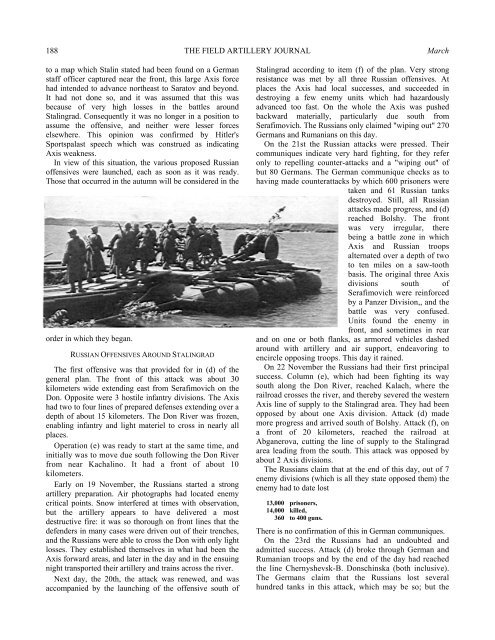the field artillery journal - Fort Sill - U.S. Army
the field artillery journal - Fort Sill - U.S. Army
the field artillery journal - Fort Sill - U.S. Army
You also want an ePaper? Increase the reach of your titles
YUMPU automatically turns print PDFs into web optimized ePapers that Google loves.
188 THE FIELD ARTILLERY JOURNAL March<br />
to a map which Stalin stated had been found on a German<br />
staff officer captured near <strong>the</strong> front, this large Axis force<br />
had intended to advance nor<strong>the</strong>ast to Saratov and beyond.<br />
It had not done so, and it was assumed that this was<br />
because of very high losses in <strong>the</strong> battles around<br />
Stalingrad. Consequently it was no longer in a position to<br />
assume <strong>the</strong> offensive, and nei<strong>the</strong>r were lesser forces<br />
elsewhere. This opinion was confirmed by Hitler's<br />
Sportspalast speech which was construed as indicating<br />
Axis weakness.<br />
In view of this situation, <strong>the</strong> various proposed Russian<br />
offensives were launched, each as soon as it was ready.<br />
Those that occurred in <strong>the</strong> autumn will be considered in <strong>the</strong><br />
order in which <strong>the</strong>y began.<br />
RUSSIAN OFFENSIVES AROUND STALINGRAD<br />
The first offensive was that provided for in (d) of <strong>the</strong><br />
general plan. The front of this attack was about 30<br />
kilometers wide extending east from Serafimovich on <strong>the</strong><br />
Don. Opposite were 3 hostile infantry divisions. The Axis<br />
had two to four lines of prepared defenses extending over a<br />
depth of about 15 kilometers. The Don River was frozen,<br />
enabling infantry and light materiel to cross in nearly all<br />
places.<br />
Operation (e) was ready to start at <strong>the</strong> same time, and<br />
initially was to move due south following <strong>the</strong> Don River<br />
from near Kachalino. It had a front of about 10<br />
kilometers.<br />
Early on 19 November, <strong>the</strong> Russians started a strong<br />
<strong>artillery</strong> preparation. Air photographs had located enemy<br />
critical points. Snow interfered at times with observation,<br />
but <strong>the</strong> <strong>artillery</strong> appears to have delivered a most<br />
destructive fire: it was so thorough on front lines that <strong>the</strong><br />
defenders in many cases were driven out of <strong>the</strong>ir trenches,<br />
and <strong>the</strong> Russians were able to cross <strong>the</strong> Don with only light<br />
losses. They established <strong>the</strong>mselves in what had been <strong>the</strong><br />
Axis forward areas, and later in <strong>the</strong> day and in <strong>the</strong> ensuing<br />
night transported <strong>the</strong>ir <strong>artillery</strong> and trains across <strong>the</strong> river.<br />
Next day, <strong>the</strong> 20th, <strong>the</strong> attack was renewed, and was<br />
accompanied by <strong>the</strong> launching of <strong>the</strong> offensive south of<br />
Stalingrad according to item (f) of <strong>the</strong> plan. Very strong<br />
resistance was met by all three Russian offensives. At<br />
places <strong>the</strong> Axis had local successes, and succeeded in<br />
destroying a few enemy units which had hazardously<br />
advanced too fast. On <strong>the</strong> whole <strong>the</strong> Axis was pushed<br />
backward materially, particularly due south from<br />
Serafimovich. The Russians only claimed "wiping out" 270<br />
Germans and Rumanians on this day.<br />
On <strong>the</strong> 21st <strong>the</strong> Russian attacks were pressed. Their<br />
communiques indicate very hard fighting, for <strong>the</strong>y refer<br />
only to repelling counter-attacks and a "wiping out" of<br />
but 80 Germans. The German communique checks as to<br />
having made counterattacks by which 600 prisoners were<br />
taken and 61 Russian tanks<br />
destroyed. Still, all Russian<br />
attacks made progress, and (d)<br />
reached Bolshy. The front<br />
was very irregular, <strong>the</strong>re<br />
being a battle zone in which<br />
Axis and Russian troops<br />
alternated over a depth of two<br />
to ten miles on a saw-tooth<br />
basis. The original three Axis<br />
divisions south of<br />
Serafimovich were reinforced<br />
by a Panzer Division,, and <strong>the</strong><br />
battle was very confused.<br />
Units found <strong>the</strong> enemy in<br />
front, and sometimes in rear<br />
and on one or both flanks, as armored vehicles dashed<br />
around with <strong>artillery</strong> and air support, endeavoring to<br />
encircle opposing troops. This day it rained.<br />
On 22 November <strong>the</strong> Russians had <strong>the</strong>ir first principal<br />
success. Column (e), which had been fighting its way<br />
south along <strong>the</strong> Don River, reached Kalach, where <strong>the</strong><br />
railroad crosses <strong>the</strong> river, and <strong>the</strong>reby severed <strong>the</strong> western<br />
Axis line of supply to <strong>the</strong> Stalingrad area. They had been<br />
opposed by about one Axis division. Attack (d) made<br />
more progress and arrived south of Bolshy. Attack (f), on<br />
a front of 20 kilometers, reached <strong>the</strong> railroad at<br />
Abganerova, cutting <strong>the</strong> line of supply to <strong>the</strong> Stalingrad<br />
area leading from <strong>the</strong> south. This attack was opposed by<br />
about 2 Axis divisions.<br />
The Russians claim that at <strong>the</strong> end of this day, out of 7<br />
enemy divisions (which is all <strong>the</strong>y state opposed <strong>the</strong>m) <strong>the</strong><br />
enemy had to date lost<br />
13,000 prisoners,<br />
14,000 killed,<br />
360 to 400 guns.<br />
There is no confirmation of this in German communiques.<br />
On <strong>the</strong> 23rd <strong>the</strong> Russians had an undoubted and<br />
admitted success. Attack (d) broke through German and<br />
Rumanian troops and by <strong>the</strong> end of <strong>the</strong> day had reached<br />
<strong>the</strong> line Chernyshevsk-B. Donschinska (both inclusive).<br />
The Germans claim that <strong>the</strong> Russians lost several<br />
hundred tanks in this attack, which may be so; but <strong>the</strong>

















